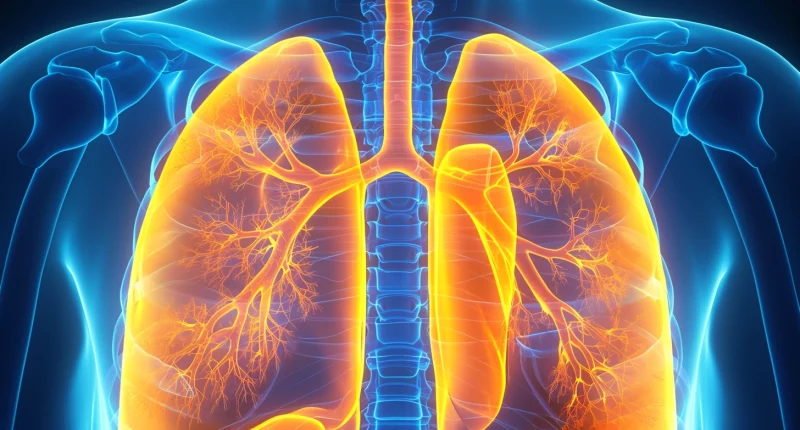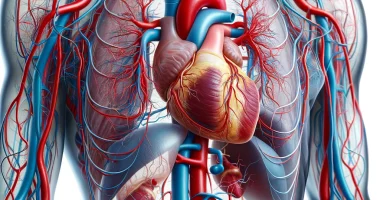Emphysema
What is it?
Pulmonary emphysema is a chronic disease in which there is an irreversible expansion of air spaces located beyond the terminal bronchioles, accompanied by destructive changes in the alveoli. As a result, the lungs seem to swell, which is externally reflected in shortness of breath, constant coughing, and difficulty breathing.
Doctors carry out treatment of pulmonary emphysema in adults: they thoroughly tell patients what it is, what is the danger of pathology, identify the causes of occurrence, and manage the symptoms of the disease with modern medicinal and non-medicinal methods.
About the disease
Pulmonary emphysema, together with chronic bronchitis and bronchial asthma, significantly reduces the quality of life, can cause serious secondary complications, and even cause disability. The pathology usually occurs in old age, predominantly in males.
In emphysema in the tissues of the alveoli occur, large-scale morphological changes, because of which the lungs “inflate”,increase in volume, and lose their elasticity. In the bronchi, mucous plugs with purulent impurities are often formed.
Types of pulmonary emphysema
According to the classification, there are two main forms of pulmonary emphysema:
- primary (congenital), when the pathology develops in isolation and on its own;
- secondary, in which the disease is a consequence of other diseases.
According to the volume of spread, localized and diffuse types of pulmonary emphysema are distinguished. According to the form, the disease can be obstructive and nonobstructive.
Taking into account the nature of the lesion of pulmonary structures regulating oxygen exchange, and anatomical features distinguish the following types of pulmonary emphysema:
- panacinar, when all acinuses (functional units of the lungs responsible for gas exchange) are involved in the process, but there are no signs of connective tissue hypertrophy and inflammation;
- centrilobular, when the damage affects the central part of the upper lung lobe against the background of fibrotic changes in the tissues;
- periacinar, when the pathologic process involves the acinuses located near the pleura;
- irregular, characterized by the formation of scar elements;
- bullous, when characteristic air cysts – bullae – form on the alveoli.
Symptoms of pulmonary emphysema
The clinical picture is not pronounced in emphysema of a mild degree at the initial stages of the disease. Symptomatology increases with the development of structural changes in the lung tissues. The first signs of the disease are dyspnea with a characteristic difficult exhalation. Difficulties with breathing arise only with physical exertion and emotional excitement but manifest themselves even at rest.
A characteristic symptom of pulmonary emphysema in adults can be called the manner of exhalation: the patient pushes the air out with almost closed lips, simultaneously inflating the cheeks.
Against the background of developing respiratory insufficiency, other signs of pulmonary emphysema occur, in particular:
- persistent cough with discharge of small amounts of sputum;
- weight loss;
- swollen neck veins;
- swelling, puffiness of the face;
- thickening of the terminal phalanges of the fingers;
- pale skin.
Spontaneous pneumothoraxes can occur in severe forms of pathology – conditions in which air accumulates in the pleural cavity.
Against the background of a long course of the disease in the patient may be observed an enlarged liver, associated with congestion in the blood vessels, a slight lowering of the diaphragm, as well as the formation of a barrel-shaped sternum and a characteristic protrusion of the supraclavicular fossa.
Causes of pulmonary emphysema
The mechanism of pathology development is based on the systematic destruction of lung tissues with loss of elasticity and increased lung pressure. Among the probable causes that can contribute to the occurrence of pulmonary emphysema include:
- smoking, including passive smoking, as well as smoking of electronic cigarettes and hookahs;
- inhalation of toxic vapors and harmful chemical compounds;
- congenital α-1 antitrypsin deficiency;
- various acute diseases of the lower respiratory tract with a severe course;
- bronchial asthma;
- microcirculatory disorders in the pulmonary structures.
Predisposing factors may include:
- occupational activities in the course of which the air pressure in the lung tissues is constantly increasing (singing glass blowers, musicians, etc.);
- work requiring close contact with harmful substances, household chemicals, and industrial production;
- living in environmentally unfavorable areas.
An important role is also played by age: the older the patient, the less elastic and robust all the tissues become, respectively, and the higher the risk of developing pulmonary emphysema and other lung diseases.
Diagnosis of pulmonary emphysema
The initial plan of action involves:
- a thorough history;
- physical exam;
- auscultation and percussion of the lungs and assessment of respiratory parameters.
Next, specialists prescribe instrumental and laboratory tests, which include:
- Radiography of the lungs, which helps to identify the nature of the pulmonary pattern, increased transparency of the lung fields, the location of the cardiac shadow, etc.;
- computed tomography, which allows the examination in detail of the localization of bullae, determines the level of diaphragmatic displacement, and clarifies the overall picture of the disease;
- various functional tests aimed at assessing the functions of external respiration (spirometry, spirography);
- general clinical studies of blood, urine;
- sputum culture study;
- microscopic examination of the sputum.
If necessary and if the patient has other systemic diseases, specialized specialists (endocrinologists, cardiologists, gastroenterologists, etc.) are involved in the examination.
Treatment of pulmonary emphysema
Unfortunately, there are no specific methods of therapy for this disease. The basis of treating pulmonary emphysema becomes eliminating the root cause – the factor that served as a starting point in the development of pathology.
Experts strongly recommend that patients:
- eliminate all forms of smoking;
- avoid the use of aggressive household and garden chemicals;
- change occupation if it aggravates the course of the disease in any way;
- do not self-medicate acute respiratory infections and other respiratory diseases.
Drug therapy for emphysema is reduced to symptomatic assistance. For each patient, doctors develop an individual drug support regimen, which, taking into account the indications, may include:
- bronchodilators;
- glucocorticosteroid agents;
- mucolytic and expectorant components.
Additionally, prescribed inhalation therapy, breathing exercises, oxygen treatment in severe respiratory failure, and drugs that improve blood supply to the lungs and the work of the cardiovascular system.
In complex cases, when conservative tactics are not justified or do not bring the desired result, the patient, after all the necessary diagnostic measures, is redirected to specialized medical institutions for intensive care or surgical treatment.
All these treatment options are available in more than 640 worldwide (https://doctor.global/results/diseases/emphysema). For example, Lung volume reduction surgery (LVRS) can be performed in 26 clinics across Germany (https://doctor.global/results/europe/germany/all-cities/all-specializations/procedures/lung-volume-reduction-surgery-lvrs).
Prevention
To reduce the risk of developing pulmonary emphysema, pulmonologists recommend:
- smoke cessation;
- devote sufficient time to exercise and physical activity;
- do not ignore medical check-ups and vaccination against potentially dangerous pathogens;
- treat infectious diseases in a timely and proper manner;
- do not use systemic antibiotics, hormones, etc., as a self-prescription;
- avoid contact with poisonous chemicals;
- use personal protective equipment when working with harmful substances.
Patients diagnosed with chronic lung diseases (COPD, bronchial asthma, chronic bronchitis, etc.) should be seen regularly by a pulmonologist.
Rehabilitation
Lack of adequate therapy for pulmonary emphysema will inevitably lead to the rapid progression of pathology and the development of respiratory and heart failure. In the absence of treatment comes the worsening of the condition and further disability. In complex, aggravated cases, there is a high probability of death.
Timely and competent treatment gives a chance for a full life. For patients who sought medical help in time changed their lifestyle, and stopped smoking, in most cases, remission occurs, and in the future, the prognosis remains favorable.




